Products are chosen independently by our editors. Purchases made through our links may earn us a commission.
The history of photography is littered with the corpses of failed camera concepts.
For every Canon Rebel, there are hundreds of products that—for one reason or another—never quite caught on. In most instances, these failures were well-deserved, whether due to inadequate specs, outrageous pricing, or just plain bad marketing. Still, many of them were based around clever, even game-changing ideas.
Below, we've collected some of the strangest products ever introduced to the camera buying public. Products so unique, so downright odd, that they've secured a place in photographic history.
Konica AiBORG
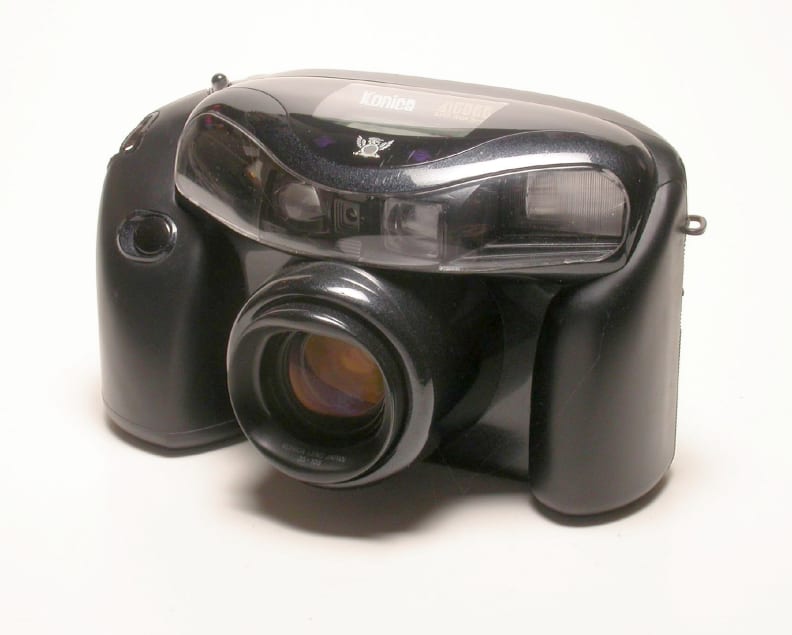
The Konica AiBORG
Looking like a cross between a Cylon and Darth Vader's helmet, the Konica AiBORG was a 35mm point-and-shoot first introduced to the public in 1991.
While the AiBORG's distressing quasi-symmetry and glitter-speckled plastic put the "ugh" in ugly, it's notable for being one of the first examples of an autofocus superzoom. Yep, your Canon PowerShot SX60 HS can trace its lineage back to this thing.
Ricoh GXR
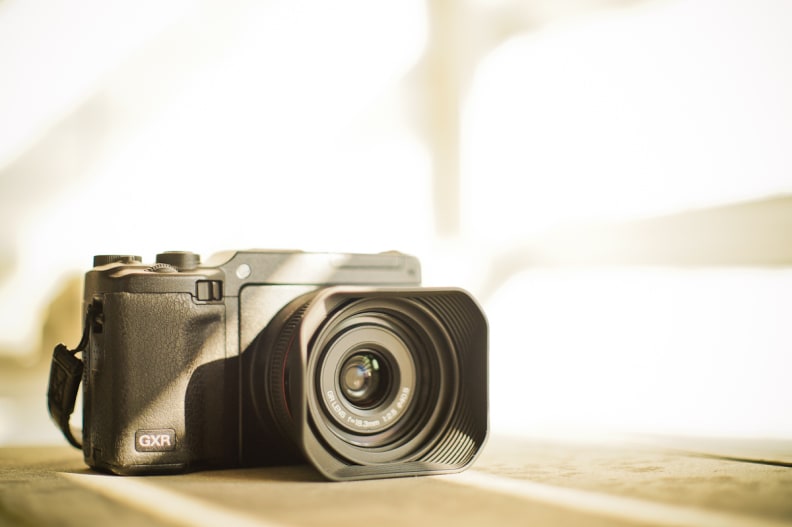
The Ricoh GXR
Interchangeable lens cameras are a dime a dozen, but interchangeable sensor cameras? That's another matter entirely.
{{amazon name="Ricoh GR II Digital Camera with 3-Inch LCD (Black)", asin="B00ZY9JJEU", align="right"}} Enter the Ricoh GXR interchangeable lens camera unit. The GXR body is little more than a grip, processor, card reader, and power supply. The real fun comes from from swapping out the detachable sensor/lens combination units.
While this system may seem strange, it does have real benefits. Pairing the lens and sensor allows for greater image quality optimization, zooms can be made smaller and more compact by using smaller sensors, and you're a lot less likely to get unsightly dust on the sensor. The downside? Well, that's obvious: You're paying for a sensor every time you get a new lens, which made the GXR modules far from cheap.
Ricoh hasn't officially discontinued the GXR system, but new products haven't been announced since 2011, so it's safe to assume it's dead as dirt.
Contax AX
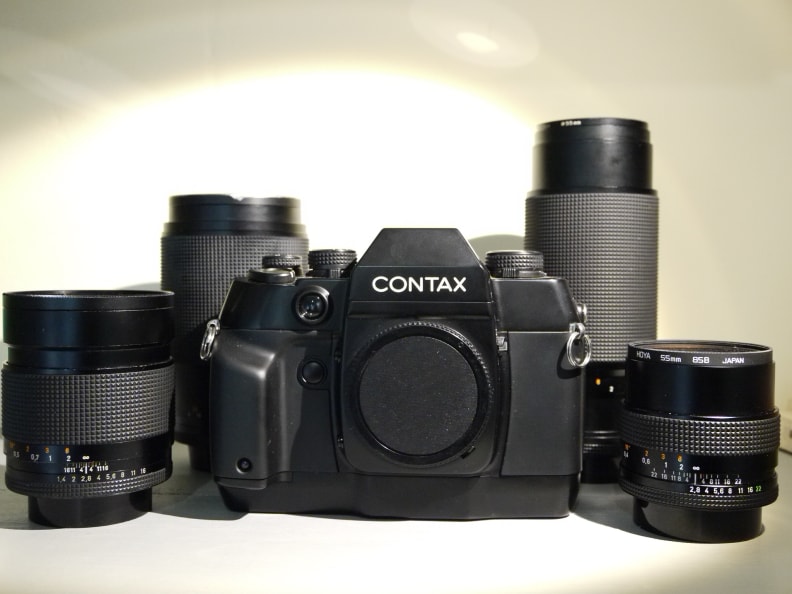
The Contax AX
On the surface, the Contax AX resembles most SLRs of its period, albeit a little stouter than most. The reason for the bulky frame? Well, that's all down to its unusual focusing system.
The AX was released in 1996, at a time when autofocus technology had saturated the market. Contax, a relatively small player with a lot of high-quality manual focus lenses in its portfolio, wanted to play catchup without creating an all-new line of AF lenses. Its solution was simple: Create an autofocus system that works with manual focus lenses.
The company drew on existing tech used in medium format cameras to devise an AF system that focused by moving the film plane closer to or further from the lens itself. And it worked surprisingly well, though not well enough to inspire a sequel or drive sales. Contax only released two more cameras before bowing out of the SLR market in 2002.
Olympus AZ-4/Ricoh Mirai
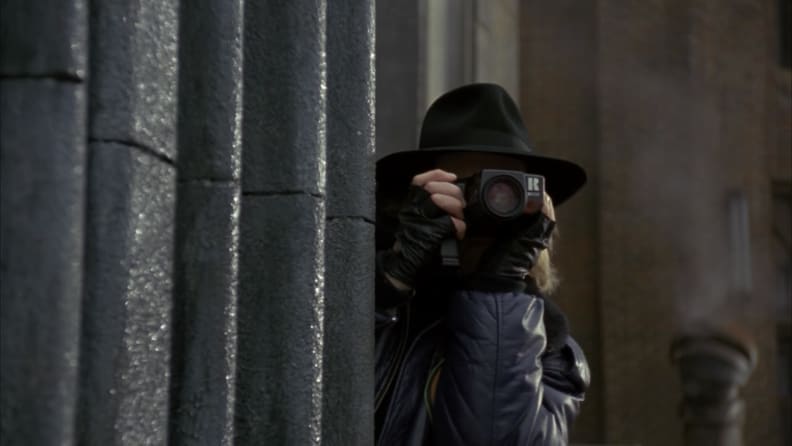
The Ricoh Mirai (Bob the Goon not included).
The bulky Olympus AZ-4 earned its place in pop culture history when it appeared in the hands of Bob the Goon in Tim Burton's 1989 Batman film.
Seminal super heroics aside, this joint venture from Olympus and Ricoh is one of the earliest examples of a superzoom. The camera featured an impressive-for-the-time fixed 35-135mm zoom lens, as well as a camcorder style handle. And boy oh boy did it look weird.
Nikon Coolpix Swivel Cameras
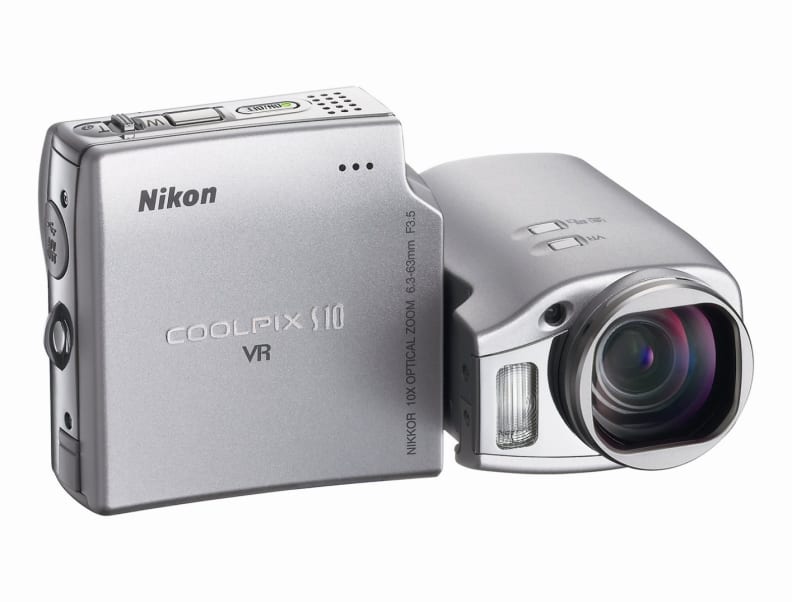
The Nikon S110
Around the turn of the 21st century, point-and-shoot cameras were in a Wild West of design. They hadn't yet settled into the familiar DSLR-or-rectangular-brick dichotomy, and the result was a cornucopia of form factors.
One of the coolest ideas came from Nikon, which made a series of swiveling cameras. Essentially, they split the camera in two, with a rotating hinge in the center. If you've ever used a camera with an articulated LCD, you'll be familiar with this concept. Nikon's take flipped the idea on its head, however, rotating the lens while the body remained in place. That provided a whole new range of unique camera angles.
Sony, for its part, took a very similar tack with its range of F-series point-and-shoots (like the Cyber-shot DSC-F707 and DSC-F828) in the early 2000s.
Pentax K-01
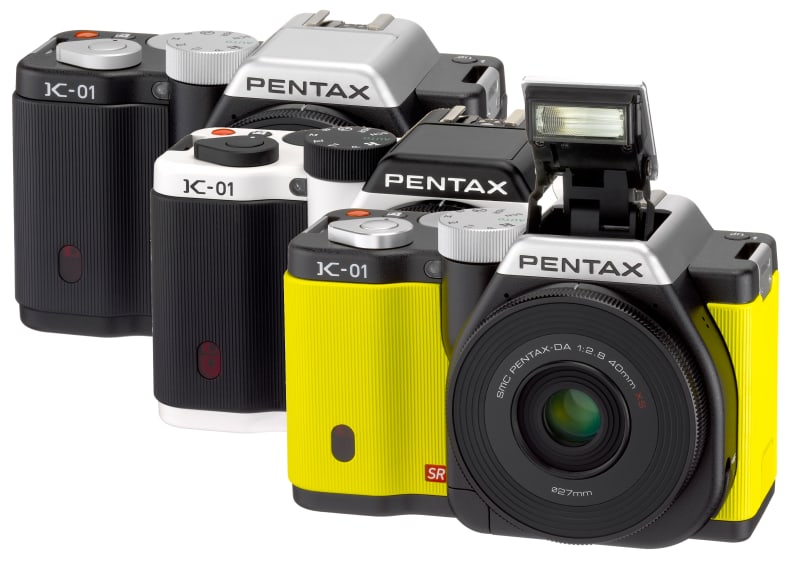
The Pentax K-01
Ah, the Pentax brick.
{{amazon name="Pentax K-S2 20MP DSLR Kit w/ 18-50mm WR (Black)", asin="B00SYIDZNY", align="right"}} One of the newest products on this list (and the only one we've actually reviewed), the eye-catching K-01 was styled by famed designer Marc Newson. It was also notable for being the first mirrorless interchangeable lens camera to support legacy lenses without the use of an adapter. Unlike most mirrorless models that required all-new lens designs, the K-01 was compatible with all K-mount lenses going back to the 1960s.
On paper, that sounds like a win-win. In practice, however, it created a bizarre sort of missing link between compact mirrorless cameras and DSLRs. In order to work with those old lenses, the K-01's body had to be made thicker than most mirrorless rivals, resulting in a camera that's as bulky and heavy as a DSLR while at the same time lacking the ergonomics and functionality you'd expect. In other words, it was a lose-lose.
Olympus Ecru
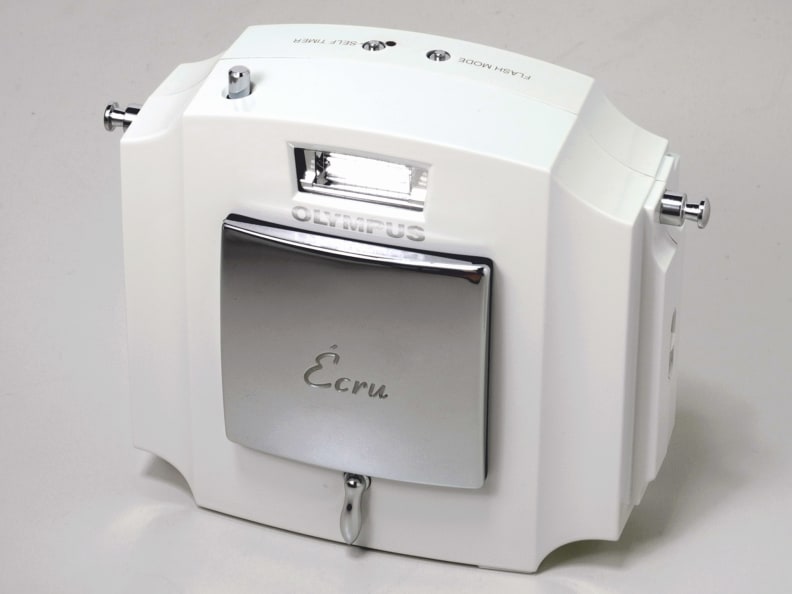
The Olympus Ecru
More like an art deco sculpture than a camera, the Ecru was a limited-edition concept from Olympus. Just 20,000 units of this quirky camera were produced and sold back in 1991.
On the surface, the Naoki Sakai–designed camera is pretty gorgeous. Just look at that all-white color scheme and aluminum lens cap! Unfortunately, the internals—based around the Olympus Stylus Infinity—were fairly mundane. This thing was a status symbol, and little more.
Zenit Photosniper
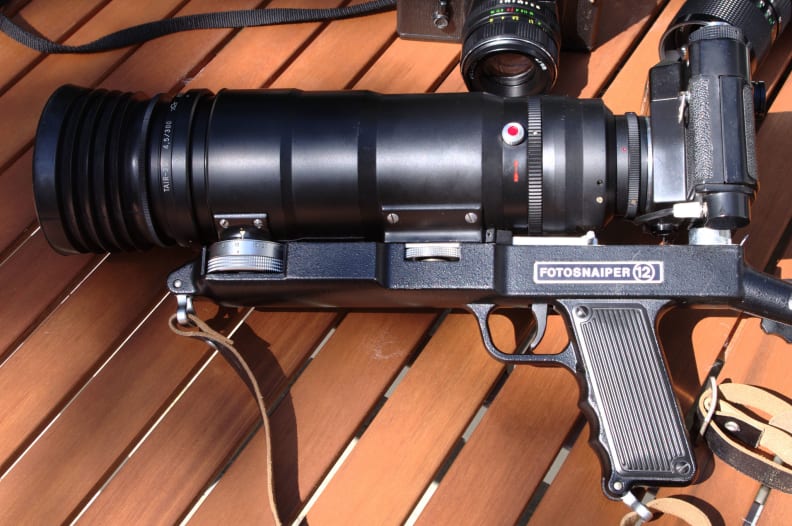
The Zenit photosniper
Ready, aim, smile!
Easily the most intimidating camera in this list, the Zenit Photosniper has its origins in the ultra-utilitarian world of battlefield photography. Designed to take advantage of the accuracy and training of military snipers, the Photosniper is a point-and-shoot camera in the truest sense possible. (Though it was actually just a gun stock for a common Zenit 35mm SLR.)
While the Photosniper was primarily used by the KGB and Russian military operatives, it's pretty common to find working models for sale on eBay.
Pentax Auto 110
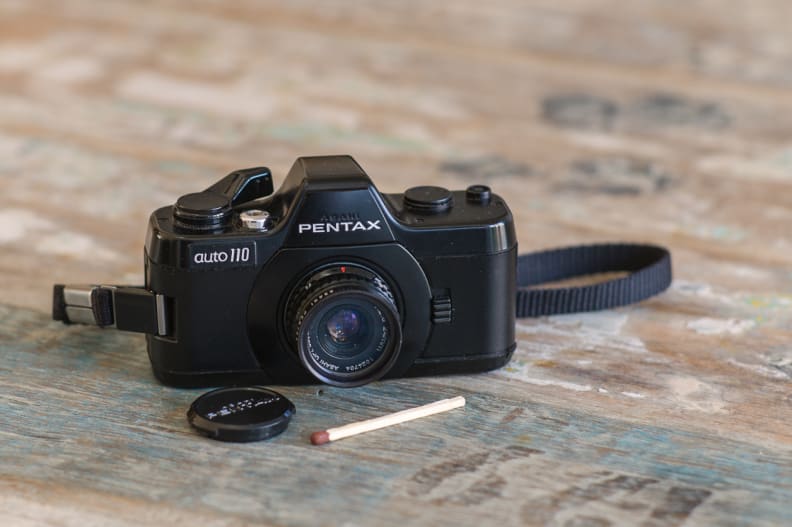
The Pentax Auto 110
Before the lilliputian Pentax Q there was the Auto 110 (or Pentax System 10, to use its more official name).
{{amazon name="Pentax PENTAX Q-S1 02 Zoom Kit (Black) 12.4MP Mirrorless Digital Camera with 3-Inch LCD (Black)", asin="B00MRX421Q", align="right"}} This petite picture box is often described as the smallest interchangeable lens SLR system ever made, and we're inclined to agree. As its name suggests, the Auto 110 made use of Kodak's tiny, convenient 110 film cartridges. The 110 supported a number of equally tiny lenses and less tiny accessories, including winder and flash units that dwarfed the camera itself.
These days, you can frequently pick up a complete set for well under $100 on eBay, and some film labs still develop old 110 film. Hipsters, eat your heart out.
Fisher-Price PXL-2000
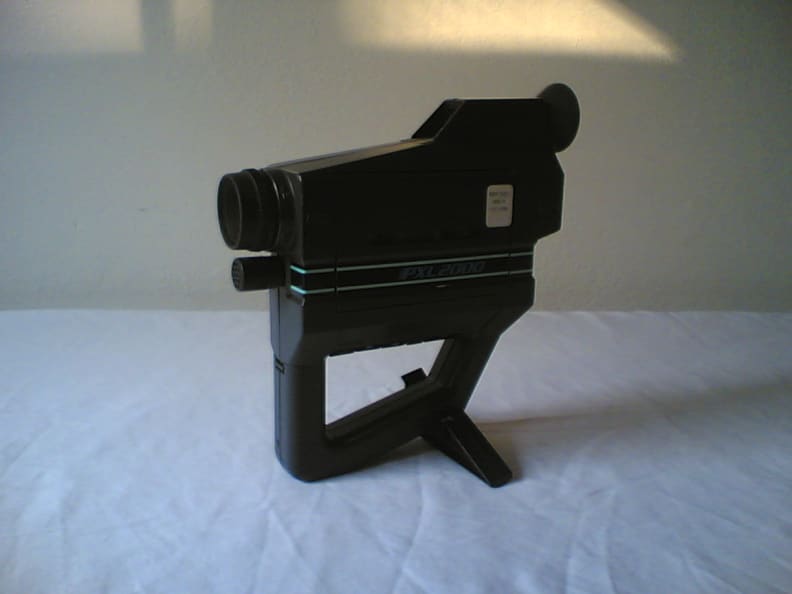
The PXL-2000
Arguably the greatest toy ever created, the Fisher Price PXL-2000 is a camcorder with a twist.
Through what we can only assume was a combination of ingenious engineering and forbidden eldrich magic, the PXL-2000 could record black and white video footage to standard audio cassette tapes.
While it didn't exactly take the world by storm, the PXL-2000 is still highly sought-after, particularly by indie and alternative film-makers who cherish its uniquely low-fi aesthetic. In fact, film buffs will recognize PXL-2000 footage from the performance art scene in Richard Linklater's seminal film Slacker.
Related Video
{{brightcove '2655241618001'}}

